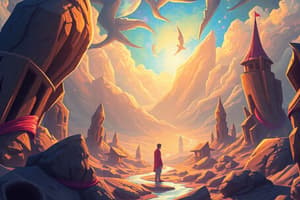Podcast
Questions and Answers
Which ancient civilization's art is known for its deep-rooted understanding of geometry, line, and form?
Which ancient civilization's art is known for its deep-rooted understanding of geometry, line, and form?
- Mughal Empire
- Indus Valley Civilization (correct)
- Mauryan Empire
- Gupta Empire
During which period did temple architecture flourish, particularly in South India under empires like Chola and Pallava?
During which period did temple architecture flourish, particularly in South India under empires like Chola and Pallava?
- Mauryan Empire
- Mughal Period
- British Colonial Era
- Medieval Period (correct)
Which artist combined traditional Indian styles with Western techniques during the British colonial era?
Which artist combined traditional Indian styles with Western techniques during the British colonial era?
- Amrita Sher-Gil
- Raja Ravi Varma (correct)
- M.F. Husain
- Nandalal Bose
Which group of artists aimed to reclaim the traditional roots of Indian art?
Which group of artists aimed to reclaim the traditional roots of Indian art?
Which empire's art is known for its realistic portrayal of human figures during ancient times in India?
Which empire's art is known for its realistic portrayal of human figures during ancient times in India?
Which empire introduced a fusion of Indian and Persian art emphasizing naturalism and realism?
Which empire introduced a fusion of Indian and Persian art emphasizing naturalism and realism?
Which literary devices do students in Class 11 English study through the texts?
Which literary devices do students in Class 11 English study through the texts?
How do students benefit from integrating History of Indian Art and English?
How do students benefit from integrating History of Indian Art and English?
Which authors' works are studied by students in Class 11 English?
Which authors' works are studied by students in Class 11 English?
What do students learn about in the study of grammar and language skills in English?
What do students learn about in the study of grammar and language skills in English?
How can studying the poetry of Mirza Ghalib and Amir Khusro benefit students?
How can studying the poetry of Mirza Ghalib and Amir Khusro benefit students?
What does integrating History of Indian Art and English help students develop an appreciation for?
What does integrating History of Indian Art and English help students develop an appreciation for?
Flashcards are hidden until you start studying
Study Notes
Class 11 Arts: Exploring History of Indian Art and English
In the realm of Class 11 Arts education, students delve into the richness of Indian heritage and the world of English literature. This article aims to provide a concise yet informative overview of these two closely intertwined subject areas.
History of Indian Art
The History of Indian Art is a captivating journey through the evolution of Indian visual arts, spanning millennia. Students explore the origins of Indus Valley Civilization art, where they learn about the seals and pottery that reveal a deep-rooted understanding of geometry, line, and form. As we move forward in time, the art of the Mauryan and Gupta Empires captivates students with their realistic portrayal of human figures.
The medieval period introduces the magnificence of temple architecture, specifically in South India, where the Chola, Pallava, and Vijayanagar Empires left a lasting legacy. The Mughal period, a fusion of Indian and Persian art, adds depth to the study of Indian art through its emphasis on naturalism and realism.
The British colonial era introduces students to the evolution of Indian art in the face of cultural change. European influence is evident in the works of artists like Raja Ravi Varma, who blended traditional Indian styles with Western techniques. Students also study the contribution of the Indian Arts Movement, a group of artists who wanted to reclaim the traditional roots of Indian art.
English
The English curriculum in Class 11 encompasses the study of classic and contemporary literature, as well as language skills and grammar. Students read texts from British and American literature, including works by William Shakespeare, Charles Dickens, and T.S. Eliot. Additionally, they study the works of renowned Indian authors like Rabindranath Tagore and R.K. Narayan.
The study of grammar and language skills is also integral to English. Students learn about the different aspects of sentence structure, word usage, and punctuation. They also explore the concept of literary devices, like metaphor, symbolism, and imagery, through the texts they study.
Integrating the Two Subjects
Integrating the two subjects can be immensely rewarding for students. For instance, while studying the art of the Mughal era, students can explore the poetry of Mirza Ghalib and Amir Khusro, which documents the period's tumultuous history and vividly depicts the beauty of Indian aesthetics.
Similarly, while studying William Shakespeare's plays, students can engage with the art of the Elizabethan era, learning about the intricate staging of theater, the importance of costumes, and the role of set design.
The integration of History of Indian Art and English provides students with a holistic understanding of Indian culture and its evolution. By studying both subjects, students develop a deeper appreciation for the richness of Indian heritage, as well as an enriched understanding of English literature.
In summary, Class 11 Arts education is an exciting journey through the depths of Indian heritage and the intricacies of English literature. By studying both History of Indian Art and English, students develop a deep appreciation for the richness of Indian culture and the beauty of the English language.
Studying That Suits You
Use AI to generate personalized quizzes and flashcards to suit your learning preferences.




